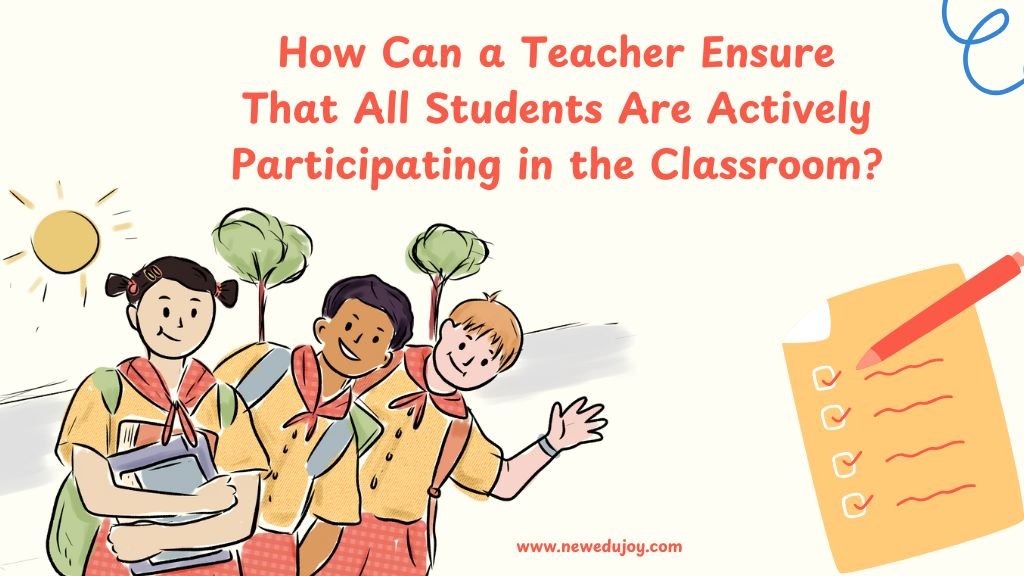A classroom is a place where students learn, grow, and interact. For this learning environment to be successful, it is important that all students participate actively. But how can a teacher ensure that all students are actively participating in the classroom? This is a question that every teacher faces. Participation helps students understand lessons better, share their thoughts, and build confidence. However, not all students are the same—some are shy, others might not understand the topic, and a few might not feel motivated.
This blog will explore simple and effective ways teachers can make sure every student feels included and takes part in classroom activities.
How Can a Teacher Ensure That All Students Are Actively Participating in the Classroom?
Create a Friendly and Inclusive Environment
The first step to encouraging participation is to create a friendly classroom where every student feels comfortable. Teachers should smile, greet students warmly, and make them feel welcome. When students feel safe and accepted, they are more likely to share their ideas.
An inclusive classroom means celebrating diversity and respecting differences. Teachers should make sure every student’s opinion is valued. For example, when a student answers a question, the teacher can respond positively and encourage others to listen. This helps create a supportive space where everyone feels important.
Also read: Why Are Net Costs of Higher Education Different From Sticker Prices?
Use Different Teaching Methods
Not all students learn in the same way. Some students learn better by listening, while others prefer hands-on activities. To ensure active participation, teachers can use different teaching methods. For example, they can combine storytelling, group discussions, visual aids, and role-playing to keep lessons interesting.
When teachers use various methods, students stay engaged and find it easier to understand the topic. For instance, a science teacher can conduct simple experiments to explain a concept instead of just reading from a book. This makes learning fun and encourages students to participate.
Ask Open-Ended Questions
Asking questions is a great way to involve students in the lesson. Instead of yes-or-no questions, teachers should ask open-ended ones. For example, instead of asking, “Is water important?” they can ask, “Why is water important in our lives?” This type of question makes students think and share their ideas.
Teachers should also give students enough time to answer. Some students may need a few moments to gather their thoughts. By being patient and encouraging, teachers can help even the quietest students participate.
Divide the Class Into Small Groups
Group activities are an excellent way to involve all students. When students work in small groups, they feel more comfortable sharing their ideas. Teachers can assign different roles to each group member, such as a leader, note-taker, or presenter. This ensures that everyone has a responsibility and takes part in the activity.
For example, in a history lesson, the teacher can divide the class into groups and ask each group to research a specific topic. Later, each group can present their findings to the class. This encourages teamwork and active participation.
Use Fun Activities and Games
Students love activities that are fun and engaging. Teachers can include educational games, quizzes, or puzzles in their lessons. For example, a math teacher can organize a quiz to solve problems in teams. This not only helps students learn but also makes them excited to participate.
Teachers can also use storytelling or role-playing to make lessons lively. For instance, during an English lesson, students can act out a scene from a story. Such activities keep the class energetic and ensure that all students are involved.
Provide Positive Feedback
Students feel encouraged when their efforts are recognized. Teachers should praise students when they participate, even if their answers are not entirely correct. For example, a teacher can say, “That’s a great try! Can someone add to what he/she said?” This way, students feel motivated to speak up without fear of being judged.
Positive feedback can also be in the form of small rewards, like stickers or certificates. This makes students feel appreciated and eager to participate more often.
Be Patient and Understanding
Some students may be shy or hesitant to participate. Teachers should understand their challenges and give them time to open up. Instead of forcing participation, they can encourage these students with simple tasks. For example, asking a shy student to read a small paragraph aloud can help build their confidence.
It is also important for teachers to avoid scolding or criticizing students who make mistakes. Mistakes are part of learning, and students should feel safe to try without fear of failure.
Use Technology in the Classroom
Technology can make lessons more interesting and interactive. Teachers can use videos, presentations, or educational apps to engage students. For example, showing a short video related to the lesson can grab students’ attention and spark discussions.
Interactive tools like smartboards or online quizzes can also encourage participation. Students enjoy using technology, and it can make learning more exciting for them.
Build a Connection With Students
When teachers build a personal connection with their students, it becomes easier to involve them in the lesson. Teachers can take time to learn about each student’s interests, strengths, and challenges. For example, if a student loves drawing, the teacher can ask them to create a diagram or illustration related to the lesson.
By showing genuine care and interest, teachers can make students feel valued and more willing to participate.
Also read: What Is the Driving Force Behind Lifelong Learning and Adaptability?
Conclusion
Active participation in the classroom is essential for effective learning. Teachers play a crucial role in creating an environment where every student feels comfortable and motivated to join in. By using friendly approaches, diverse teaching methods, fun activities, and positive feedback, teachers can ensure that all students are actively involved. It’s also important to be patient, understanding, and use technology to make lessons more engaging. When students participate, they learn better, gain confidence, and enjoy their time in the classroom.
Let us remember that every child has the potential to contribute, and it’s the teacher’s responsibility to help them shine.

